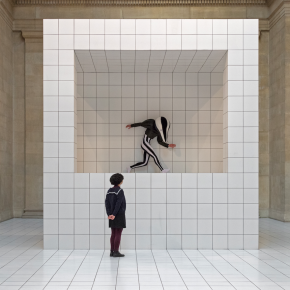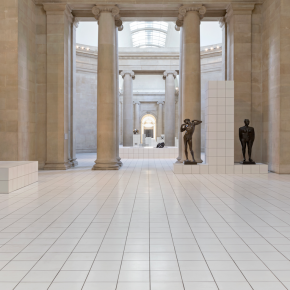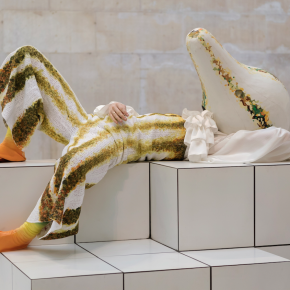
An Artistic Uncoupling of Tile at Tate Britain with Schluter
Schlüter®-DITRA 25 uncoupling membrane is ensuring a crack-free finish for the tile within 2016 Turner Prize nominee Anthea Hamilton’s recent commission for the prestigious Duveen Galleries.
One British artist a year is invited to produce a new work for the signature space, which constitutes the heart of one of the UK’s most famous art galleries.
Hamilton’s piece, entitled ‘The Squash’, sees performance meet sculpture in a truly immersive experience.
The installation involved tiling the length of the Duveen Galleries; contacted by curator Linsey Young, Schlüter donated its market-leading uncoupling membrane for use beneath the white tiles laid above the galleries’ terrazzo floor.
1,300 square metres of Schlüter®-DITRA 25 was installed and tiled in the lead up to the exhibition opening on 22 March.
Creating a striking contrast with Tate Britain’s neo-classical architecture, the commissioned work will remain in situ until 7 October, meaning a 6-month run which is expected to attract approximately 700,000 visitors.
One performer per day takes to the tiles from 10am-6pm, clad in their choice of one of seven costumes designed by Jonathan Anderson, Creative Director of luxury clothing and accessory brand, Loewe.
The project marks Schlüter-Systems’ second involvement with Tate Britain; with the first being back in 2011, where the company took part in the £45 million renovation of the Grade II listed Millbank building, led by architecture firm Caruso St John.
The renovation involved the creation of new education and events rooms, including the art gallery’s Djanogly café and opened in November 2013; this saw DITRA 25 used again, for uncoupling provision beneath agglomerate stone or unglazed porcelain floor tiles, dependent on the rooms and areas in question.
Cement-free tile backerboard, Schlüter®-KERDI-BOARD can be found supporting wall tiling in the WCs and kitchens.
Schlüter®-DILEX movement joints, in a range of variants, can be seen within the floors and walls of these areas, helping to maintain crack-free coverings.
Schluter-Systems
Units 3-5 Bardon 22
Beveridge Lane
Coalville
Leicestershire
LE67 1TE
UK
01530 813396
Visit the Schluter-Systems website
Visit Supplier's page
Latest news

21st November 2024
Altro distils style and performance at English Spirit
English Spirit Distillery has used an extensive package of Altro products front and back of house, in their new visitor centre café, shop and viewing area for the working distillery.
Posted in Articles, Bathrooms, Bedrooms & Washrooms, Building Industry News, Building Products & Structures, Building Systems, Case Studies, Floors, Interior Design & Construction, Interiors, Kitchens, Restoration & Refurbishment, Retrofit & Renovation, Timber Buildings and Timber Products, Walls
21st November 2024
Abloy UK creates bespoke locking solution for Secure Information Boxes
Abloy UK has supplied The Safety Letterbox Company Ltd with a bespoke Sentry CL811 Camlock for use in its Secure Information Boxes, assisting life safety and complying with new regulations and legislation for high rise buildings.
Posted in Access Control & Door Entry Systems, Architectural Ironmongery, Articles, Building Industry News, Building Products & Structures, Building Regulations & Accreditations, Building Services, Case Studies, Facility Management & Building Services, Health & Safety, Posts, Restoration & Refurbishment, Retrofit & Renovation, Security and Fire Protection
20th November 2024
CUPA: CUPACLAD enhances hotel aesthetics with a creative natural slate façade
Situated at the northern edge of a newly developed retail park near Bristol, the Abbey Wood Travelodge was conceived as part of the company’s new Budget-Luxe line of hotels – it features CUPACLAD, from CUPA PIZARRAS.
Posted in Articles, Building Industry News, Building Products & Structures, Building Systems, Case Studies, Cladding, Concrete, Cement, Admixtures, Facades, Posts, Restoration & Refurbishment, Retrofit & Renovation, Walls
20th November 2024
Origin launches in-house powder coating facility
Origin’s latest investment is set to redefine industry standards as it launches its own in-house powder coating facility.
Posted in Aluminium Products, Articles, Building Industry News, Building Products & Structures, Building Systems, Doors, Glass, Glazing, Innovations & New Products, Paints, Coatings & Finishes, Restoration & Refurbishment, Retrofit & Renovation, Site Preparation, Windows
 Sign up:
Sign up: 
